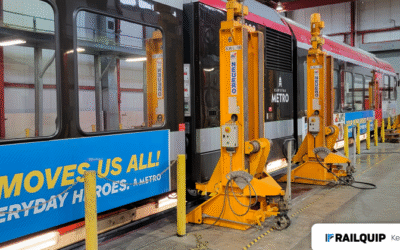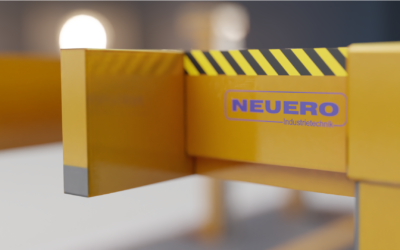Table of contents
Organizations dealing with moving machines have to get prepared and plan for their routine maintenance practices. These entities must develop proper mechanisms that will help them deal with unpredictable breakdowns.
The rail and railway industries are not an exception and must have a fully functional supply chain. Consequently, rail maintenance have remained a critical issue in ensuring that stakeholders in the industry maintain their track records and success.
The global transport economy has experienced a great increase in the population of passengers that consider the railway infrastructure as their major form of haulage. This explains why 24/7 rail services have increased in popularity. However, periodic delays and trail malfunctions have also increased with an increase in the productivity margins depicted by the industry.
Here are six railway maintenance problems and how to solve them.
#1 Schedule planning
Governments across the globe have made heavy investments in their rail infrastructure. Today, railroad tracks extend millions of miles crisscrossing countries to foster effective transportation of goods and services among nations and economic blocks.
This shows why it is never a small matter to institute constant checks and regular inspections when dealing with rail. Similarly, the railway infrastructure faces exceptional environmental and physical conditions that cause track damages which call for urgent attention.
To deal with these unpredictable yet urgent maintenance demands, stakeholders in the railway industry must alter the limited resources at their disposal and the scheduled maintenance operations to meet pressing needs and keep the locomotives moving. In addition, to avoid the bottlenecks associated with urgently scheduled maintenance practices, stakeholders must incorporate strategies that will inform them of the real-time condition of the rail.Click here to know more about how to create a proactive maintenance schedule for your railway operations
#2 Climate change
The effects of climate change have been experienced all over the globe. From the constant snow-piles to adversely hot conditions, climate change is taking a toll on the established rail infrastructure. It may be a major cause of havoc that must be considered when initiating maintenance.
Climate change issues like the extreme summer heat, extreme storms, and ice-cold winters harm the safety levels of the rail infrastructure.
They may also lead to a great increase in the associated repair and maintenance costs and periodic interruptions to just-in-time transportation of passages and cargo.
Climate change is indeed a naturally occurring phenomenon whose effects are associated with past human negligence. For example, the summer heat has been associated with rail buckling and exposure to instabilities barriers.
On the other hand, ice-cold winters have led to ice formation in rail tunnels, trains, and train equipment. Such climate-related challenges could be handled with great ease by adopting weather-sensitive materials when developing the associated rail infrastructures.
At the same time, it is necessary to note that elements related to climate change are of higher consequence to the train sector. It is essential to mention it will not be a walk in the park to deal with issues that may occur and that the maintenance equipment may require more upgrades and development in the future for the best returns.
Climate change is one factor that many participants in the industry must account for when thinking about equipment, maintenance, repairs, and long-term sustainability.
#3 Communication
The railway industry is made up of a vast network with interdependent assets and operations. This denotes why it is a near-impossibility to attain efficient railway maintenance operations without embracing effective communication structures. Similarly, railway maintenance only takes place when the associated stakeholders welcome close collaborations since some of the procedures will be time-sensitive and may cause both fiscal and structural losses,
Communication challenges in railway maintenance can be dealt with by embracing consistent models that are reliable and easy to use among the concerned entities. In essence, stakeholders in the industry should adopt communication tools that foster correct and timely reporting of the inspection data.
Indeed, effective communication may not be at the top of your list when thinking about maintenance, equipment, and train matters. Still, it does certainly make a significant difference in your life. Conversely, the lack of communication can create significant maintenance problems and add to costs within your facilities and the system in general.
Yes, communication seems to be a part of the service field that should be accounted for in your operation at a fundamental level. But the cost of not having this as part of your key process can cause transit issues, railways, transit, and machine factors.
#4 Track inspection
Track inspection is key to ensuring that the railway infrastructure operates in the desired manner. However, the industry hasn’t adopted proper technologies to foster effective rail inspections. This reveals why most of the rail inspections are visual.
Here, the rail inspector initiates the process by walking or driving in a Hy-rail truck through the rails to confirm any structural and mechanical issues by measuring the gauge and examining track conditions. However, manual track inspections could be ineffective, time-consuming, and require an additional workforce to meet the desired objectives.
Dealing with rail inspection is key in ensuring effective rail maintenance operations. Stakeholders in the industry could deal with the inspection challenge by adopting digital surveillance mechanisms through the rail tracks. Such efforts will foster real-time detection of any mechanical difficulties facing the rails. Conversely, the industry could solve the inspection problem by ensuring a high level of availability across the entire life cycle of the railway infrastructure.
You might also be interested in…Making the right choice: Factors to consider for Rail Maintenance Equipment
#5 Lack of innovation
The railway industry has been available for quite some time. For some quotas, rail is treated as a traditional mode of transport that requires minimal innovation. Even though most developed economies have tried to incorporate technologies in their rail sector, certain infrastructure elements have remained unchanged.
The sector has experienced the introduction of electric systems and high-speed trucks, and modes of carriage. However, the rails have remained the same. This reveals the unbalanced framework adopted when dealing with the rail infrastructure.In essence, railway operating companies must look into modernizing and enhancing the quality of services they offer if they are at pace with the ever-evolving consumer demands. In addition, stakeholders need to adopt augmented reality and holographic projection technologies to allow for effective maintenance without facing excessive travel costs.
#6 Procurement issues
Railway maintenance can be resource-draining and must be planned with utmost professionalism. In essence, procurement issues have acted as significant hindrances to effective rail maintenance all over the globe, considering the enormous amounts of resources involved.
Similarly, most rail stakeholders have adopted franchising systems that only allow for cyclical investments, which only present narrow windows of opportunities among the value chain stakeholders, coupled with long and complicated procurement procedures.
Such operations have only led to fragmentation in the rail infrastructure and ineffective maintenance activities.
Stakeholders could deal with the underlying procurement challenges by adopting programs within the industry that will offer support for both the established rail maintenance organizations and the new entrants. Similarly, the procurement issues could be addressed by eliminating barriers that deter smallholder organizations and startups from bidding for rail maintenance contracts.
Stakeholders may also stress the need for procurement teams to have a clear grasp of the requirements placed by their service delivery teams to ensure that the maintenance operations are as swift as desired to minimize delays.
Get some tips to choose a reliable railroad equipment supplier here.
A range of components and issues that can go wrong in railway lines
The best way to serve customers within the industry to ensure that everything operates at the best level. That means that regular care of the system is vital in moving goods along.
It is necessary to understand that there are more specific problems to be aware of regarding your facility and the freight business in general. What are a few of these issues that one must efficiently deal with in their engineering and maintaining plans?
A common concern within the industry is that of wear and tear the depreciation rate within the various parts of the train system. The more wear and tear that is present within the rails, the more likely that they are to break down and stop working. This is present within elements such as slipping rails, where engineers may respond to it by loosening the screws on the tracks, so they don’t grip as tightly.
There is another common issue that revolves around short rails. When it comes to short rails, one will notice that the simple solution is to ensure to use the right amount of force when tightening the screws on the tracks. Again, this is a simple problem that comes with a simple solution.
One other issue that many people will deal with in their time in the rail sector is wobbly rails. These rickety rails will require you to use a straight metal edge to check for unevenness in your rail. Then you will want to tighten any loose bolts with nuts and washers until all of the wobblings have gone away.
These are the problems people deal with while planning for the best way to make everything within their operation work. Whether they are dealing with grinding or other tasks together, they will implement the right work over time to foster the complete and effective movement of goods.
Key Questions on Railway Maintenance
1. What are the essential types of railway maintenance equipment and what are their specific uses?
Answer: Essential equipment includes Railway Maintenance Equipment for inspections and track upkeep; Railway Cranes and Lifting Equipment for repairs and heavy handling; Railcar Movers for safe movement in yards; Rerailing Equipment for accident recovery; Railshop/Railyard Equipment for full vehicle maintenance; and Testing and Assembly Tools for quality control.
Explore Railquip’s full product range to see how each specialized tool enhances railway operations: https://www.railquip.com/products/
2. What advanced automation solutions are available to mitigate the operational challenges posed by extreme climate conditions on railway lines?
Answer: Automation plays a crucial role by enabling tasks to be performed faster and in conditions unsafe for humans. Automated inspection systems and remote-controlled Railcar Movers can operate effectively despite adverse temperatures or heavy snowfall, minimizing delays and maintaining operational continuity.
Our robust Railcar Movers and specialized Railway Maintenance Equipment are engineered for reliable performance across diverse environmental conditions, enhancing your operational capacity and safety regardless of the weather.
3. What are the latest advancements in sustainable railway maintenance practices, and how can equipment choices contribute to environmental goals?
Answer: Sustainable maintenance focuses on minimizing environmental impact. Advancements include using eco-friendly lubricants and materials, implementing energy-efficient equipment, and adopting practices that reduce waste and emissions. Equipment choices contribute by selecting tools with lower fuel consumption, reduced noise levels, and recyclable components.
Railquip is committed to sustainability. Our range includes Railway Maintenance Equipment designed for fuel efficiency and reduced emissions, helping operators meet their environmental targets.
4. What’s the difference between preventive, predictive, and corrective maintenance in railways?
Answer: Preventive maintenance involves scheduled tasks (e.g., routine inspections) to prevent failures. Predictive maintenance uses data and sensors to forecast when failures might occur, allowing for maintenance just before an issue arises. Corrective maintenance addresses problems after they’ve happened, focusing on repairs to restore functionality.
Railquip’s Railway Maintenance Equipment supports all three approaches: from tools for routine preventive checks to advanced Testing and Assembly equipment for predictive diagnostics and robust Rerailing Equipment for corrective actions.
5. What are the biggest safety concerns in railway maintenance work?
Answer: Key safety concerns include working near live tracks and moving trains, electrocution risks from overhead lines, injuries from heavy machinery and lifting operations, exposure to hazardous materials, and the dangers of working in extreme weather. Proper training, strict protocols, and reliable equipment are essential to mitigate these risks.
Railquip prioritizes safety. Our Railway Cranes, Lifting Equipment, and all other Railway Maintenance Equipment are designed with advanced safety features to protect personnel during all types of maintenance operations.



